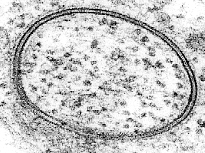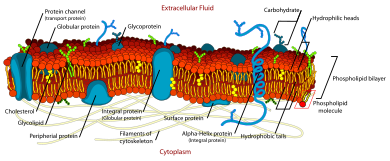History of cell membrane theory

[It is found in 1838.]]
Early barrier theories
Since the invention of the microscope in the seventeenth century it has been known that plant and animal tissue is composed of cells : the cell was discovered by Robert Hooke. The plant cell wall was easily visible even with these early microscopes but no similar barrier was visible on animal cells, though it stood to reason that one must exist. By the mid 19th century, this question was being actively investigated and Moritz Traube noted that this outer layer must be semipermeable to allow transport of ions.[1] Traube had no direct evidence for the composition of this film, though, and incorrectly asserted that it was formed by an interfacial reaction of the cell protoplasm with the extracellular fluid.[2]
The
Discovery of lipid bilayer structure

Thus, by the early twentieth century the chemical, but not the structural nature of the cell membrane was known. Two experiments in 1924 laid the groundwork to fill in this gap. By measuring the
A decade later,
Evolution of the membrane theory
The idea of a
The emergence of the steady-state membrane pump concept
With the development of
The modern view of the
Fluid mosaic model

Around the same time the development of the first model membrane, the painted bilayer, allowed direct investigation of the properties of a simple artificial bilayer. By “painting” a reconstituted lipid solution across an aperture, Mueller and Rudin were able to determine that the resulting bilayer exhibited lateral fluidity, high electrical resistance and self-healing in response to puncture.[15] This form of model bilayer soon became known as a “BLM” although from the beginning the meaning of this acronym has been ambiguous. As early as 1966, BLM was used to mean either “black lipid membrane” or "bimolecular lipid membrane".[16][17]
This same lateral fluidity was first demonstrated conclusively on the cell surface by Frye and Edidin in 1970. They fused two cells labeled with different membrane-bound fluorescent tags and watched as the two dye populations mixed.[18] The results of this experiment were key in the development of the "fluid mosaic" model of the cell membrane by Singer and Nicolson in 1972.[19] According to this model, biological membranes are composed largely of bare lipid bilayer with proteins penetrating either half way or all the way through the membrane. These proteins are visualized as freely floating within a completely liquid bilayer. This was not the first proposal of a heterogeneous membrane structure. Indeed, as early as 1904 Nathansohn proposed a “mosaic” of water permeable and impermeable regions.[20] But the fluid mosaic model was the first to correctly incorporate fluidity, membrane channels and multiple modes of protein/bilayer coupling into one theory.
Modern research
Continued research has revealed some shortcomings and simplifications in the original theory.[21] For instance, channel proteins are described as having a continuous water channel through their center, which is now known to be generally untrue (an exception being nuclear pore complexes, which have a 9 nm open water channel).[22] Also, free diffusion on the cell surface is often limited to areas a few tens of nanometers across. These limits to lateral fluidity are due to cytoskeleton anchors, lipid phase separation and aggregated protein structures. Contemporary studies also indicate that much less of the plasma membrane is “bare” lipid than previously thought and in fact much of the cell surface may be protein-associated. In spite of these limitations, the fluid mosaic model remains a popular and often referenced general notion for the structure of biological membranes.
Obsolete theories
The modern mainstream consensus model of cellular membranes is based on the fluid-mosaic model that envisions a lipid bilayer separating the inside from the outside of cells with associated ion channels, pumps and transporters giving rise to the permeability processes of cells. Alternative hypotheses were developed in the past that have largely been rejected. One of these opposing concepts developed early within the context of studies on
As support for the lipid bilayer membrane theory grew, this alternative concept was developed which denied the importance of the lipid bilayer membrane. Procter & Wilson (1916) demonstrated that gels, which do not have a
Some criticisms of the membrane theory developed in the 1930s, based on observations such as the ability of some cells to swell and increase their surface area by a factor of 1000. A lipid layer cannot stretch to that extent without becoming a patchwork (thereby losing its barrier properties). Such criticisms stimulated continued studies on protoplasm as the principal agent determining cell permeability properties. In 1938, Fischer and Suer proposed that water in the protoplasm is not free but in a chemically combined form, and that the protoplasm represents a combination of protein, salt and water. They demonstrated the basic similarity between swelling in living tissues and the swelling of gelatin and fibrin gels. Dimitri Nasonov (1944) viewed proteins as the central components responsible for many properties of the cell, including electrical properties.
By the 1940s, the bulk phase theories were not as well developed as the membrane theories and were largely rejected. In 1941, Brooks & Brooks published a monograph The Permeability of Living Cells, which rejects the bulk phase theories.[24]
References
- ^ Jacques Loeb, The Dynamics of Living Matter. Columbia University Biological Series, ed. H. F. Osborn and E. B. Wilson. Vol. VIII. 1906. New York: Columbia University Press.
- .
- PMID 17730464.
- ^ O Hertwig, M Campbell, and H J Campbell, “The Cell: Outlines of General Anatomy and Physiology.” 1895. New York: Macmillan and Co.
- .
- ^ B Moore, Secretion and glandular mechanisms, in Recent advances in physiology and biochemistry, L. Hill, Editor. 1908. Edward Arnold: London.
- ^ H Fricke."The electrical capacity of suspensions with special reference to blood." Journal of General Physiology, (1925) 9. 137-152.
- ^ E Gorter and F Grendel."On bimolecular layers of lipids on the chromocytes of the blood." Journal of Experimental Medicine, (1925) 41. 439-443.
- ^ P L Yeagle, The Membranes of Cells. 2nd Ed. ed. 1993, San Diego, CA: Academic Press, Inc.
- ^ J F Danielli and H Davson."A contribution to the theory of permeability of thin films." Journal of Cellular and Comparative Physiology, (1935) 5. 495-508.
- ^ F S Sjöstrand, E Andersson-Cedergren, and M M Dewey."The ultrastructure of the intercalated discs of frog, mouse and guinea pig cardiac muscle " Journal of Ultrastructure Research, (1958) 1. 271-287.
- ^ J D Robertson."The molecular structure and contact relationships of cell membranes." Progress Biophysics and Biophysical Chemistry, (1960) 10, 343-418.
- ^ J D Robertson."The ultrastructure of cell membranes and their derivatives." Biochemical Society Symposium, (1959) 16. 3-43.
- PMID 19872189.
- ^ P Mueller, D O Rudin, H I Tien, and W C Wescott."Reconstitution of cell membrane structure in vitro and its transformation into an excitable system." Nature. (1962) 194. 979-980.
- ^ H T Tien, S Carbone, and E A Dawidowicz."Formation of "black" lipid membranes by oxidation products of cholesterol." Nature. (1966) 212. 718-719.
- ^ H T Tien and A L Diana."Some physical properties of bimolecular lipid membranes produced from new lipid solutions." Nature. (1967) 215. 1199-1200.
- ^ L D Frye and M Edidin."The rapid intermixing of cell surface antigens after formation of mouse-human heterokaryons." Journal of Cell Science. (1970) 7. 319-335.
- ^ S J Singer and G L Nicolson."The fluid mosaic model of the structure of cell membranes." Science. (1972) 175. 720-731.
- ^ A B Macallum, The significance of osmotic membranes in heredity, in The Harvey Lectures. 1910. J B Lippincott Company: Philadelphia.
- ^ J D Robertson. "Membrane Structure." The Journal of Cell Biology. (1981) 91. 189s-204s.
- ^ B Alberts, A Johnson, J Lewis, M Raff, K Roberts, and P Walter, Molecular Biology of the Cell. 4th Ed. ed. 2002, New York: Garland Science.
- ISBN 0306414090.
- PMID 17837973.
Further reading
- M Edidin."Lipids on the frontier: a century of cell-membrane bilayers." Nature Reviews Molecular and Cellular Biology, (2003) 4, 414–418.
- J D Robertson. “Membrane structure.” The Journal of Cell Biology. (1981) 91. 189s-204s.
